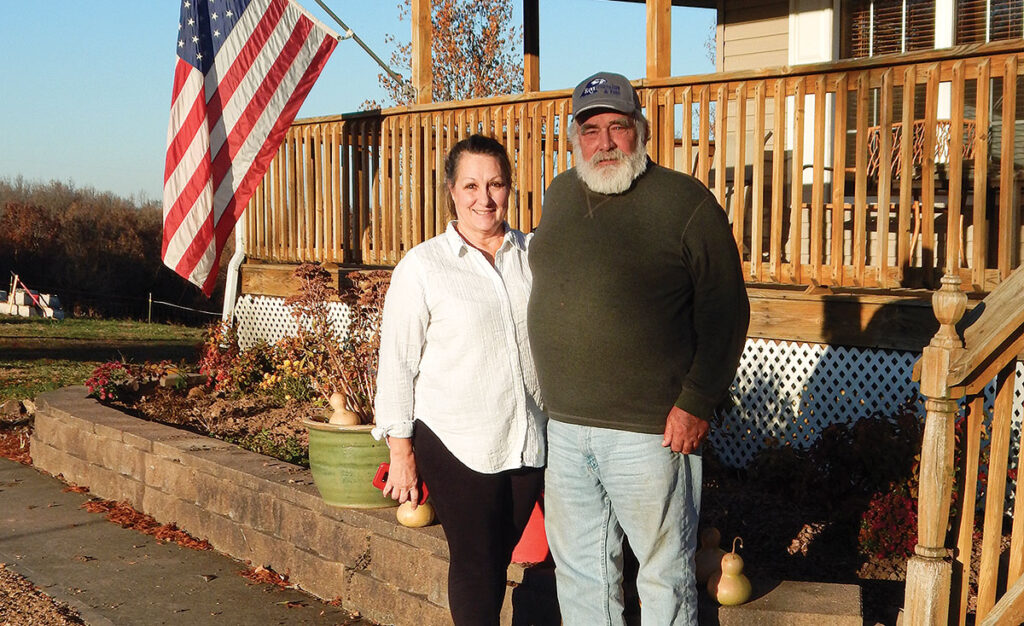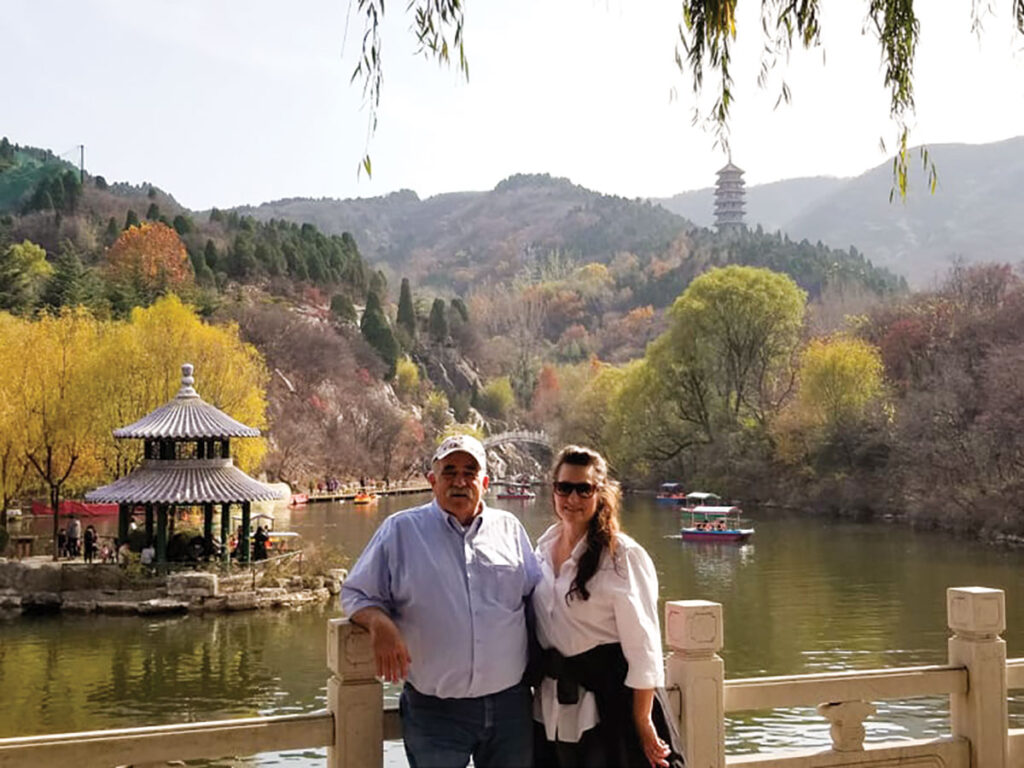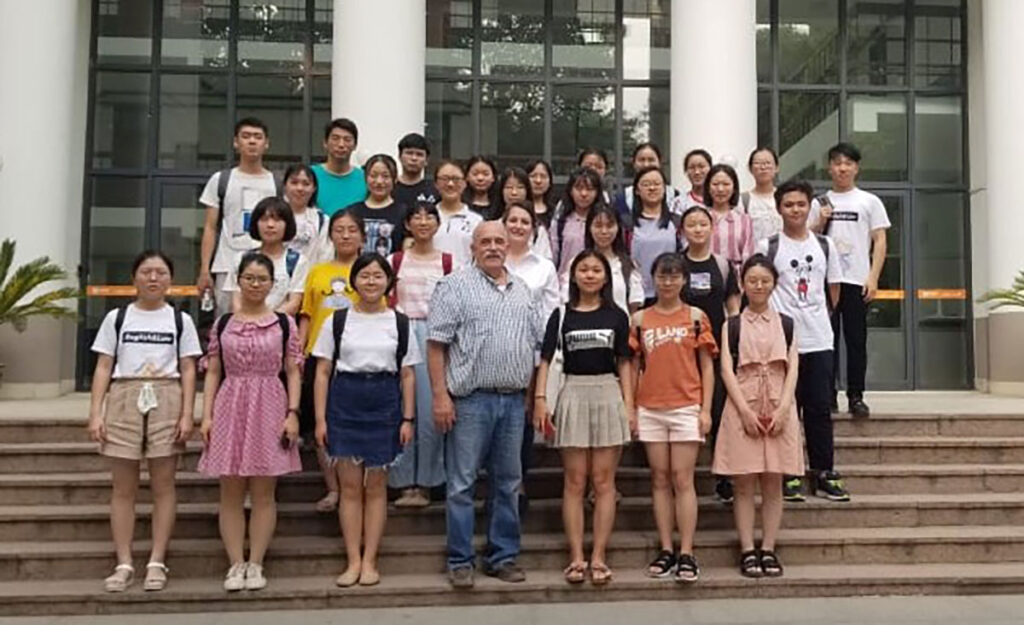
After retirement, Jay Wilkins is still learning about agriculture
EUDORA, MO. – Growing up on a farm does not mean you will want to spend all your life in the world of agriculture. Sometimes you must leave the farm to find out that what is in your DNA is hard to remove. Sometimes agriculture takes you places that you never thought you would go, and such is the story of Jay and Tresa Wilkins, retirees.
In 1968, Doyle and Mabel Wilkins moved from the dry high deserts of Arizona to 400 fertile acres of rolling hills in southern Missouri, roughly 20 miles north, of Springfield. The large family would come to grow to 12 children, and the sprawling hills east of Eudora, Mo.
Jay Wilkins was one of those children raised on the farm. He said he is a minor player on the family farm, which typically raises Angus or Hereford crosses. He now resides on a portion of the farm and can see his mother’s home from his front porch.
The home place is now where one of his younger brothers lives and raises cattle. The original family farm now is close to 1,500 acres with several additional acres owned by other family members throughout Polk County, Mo.
“My story cannot be told without telling you that this farm is a cattle-raising farm, but we also raise kids and it is about family, getting together to spend time together and have fun,” Jay reflected.
But he was not always sure that staying in agriculture was what he wanted his life’s path to take, so he worked at several other occupations: including Mid-Am Dairy for a year, then a nuclear power plant in Kansas. He also ventured into construction, which allowed him to travel the nation building horse barns in all but three states in the union.
“It was a good young man’s job,” Jay said. “I had an epiphany one night while living with some buddies in a trailer houses; is this what I want for myself? I didn’t have a job that was conducive to having a family so I decided to go back to school.”
While at college, he and some other students raised 1,200 baby calves to help pay for some of their college at Utah State University and then for five years he assisted with ag projects.
When considering the impact that cattle have on the everyday lives of individuals, Jay pointed to an aspect many may not be aware of — medical research. In the early 1980s, he indirectly worked with the research project at Utah State for the Jarvik – 7 artificial heart, caring for Holstein bull calves who were the first to receive the prototype mechanical hearts.
Later he assisted with projects tied to gluten, protein studies on chicken litter and feathers but their big project was on bST, Bovine somatotropin, a metabolic protein hormone used to increase milk production in dairy cows.
“There are so many medical things that come from agriculture,” Jay states. “When I graduated from college, I went into research, and I saw a lot of different things that agriculture has done to improve the quality of medical care in our lives.”
He finally landed at Crowder College outside of Neosho, Mo., where he worked for 27 years in varying capacities but by the end of his tenure, he headed the Crowder Agriculture Department, as an instructor and department chairman.
During his time at Crowder, he began to see the value in taking the ag students to other countries to better understand the different farming and ranching practices elsewhere. Through his efforts a new Ag Travel seminar in the Crowder Ag program began, taking students who have never been out of their home county outside their area and overseas.
“One thing I taught my students at Crowder was; Don’t try to adjust your environment to the cattle, adjustment your cattle to your resources and use a management style that works best for you,” Jay said.
“Here is something that most people don’t consider; ag is in everything to some degree and everything else is in ag,” Tresa, who also worked at Crowder as a business and industry instructor said. “I would always tell my students to carefully consider what they want to study and their life’s career. People have to eat, and people have to wear clothes.”
Jay has raised Angus, Herefords, Charolais, Simmentals, Shorthorns, Piedmontese, and Jersey and Holstein steers.
“All my life we focused on production, production, production rather than quality but about two years before I left Crowder I got into Wagyu. And because I was retiring, I could play around with trying out the breed without much impact on our resources,” Jay said.

Because Wagyu are slow growers, they typically butcher around 28 to 36 months, but they put on a tremendous amount of weight. He realized because the meat is so unique and sought after, the price is often out of the range of most families.
Wagyu are a large investment. Being the consummate researcher at heart, Jay decided to invest in cows that were half Wagyu and then purchased a full-blooded bull. And then he began breeding up. Currently of his calves, 7/8s is the highest he has achieved.
After doing some research to develop a carcass with the same intermuscular fat quality but more affordable in size, Jay settled on Dexter cattle and Lowline Angus to cross with his Wagyu bull. His thought process is to get the carcass down to 300 or 400 pounds, making it more affordable for the average family and beef lover.
He said his first concern was the size of calves at birth, however, Wagyu tend to have smaller calves. So, with the purchase of his first Dexter cow, he bred her to his bull and she calved with no problem.
“When I first bought this little cow, I couldn’t believe how small she was. Almost like a large dog,” Jay said.
Wagyu are not good milk producers; therefore, he has decided to try a Wagyu/Jersey cross to see if he can improve on the milk production and potentially increase the growth rate in the breed.
“My goal has never been to sell cows,” Jay said. “My goal is to sell meat.”
He points to the surge in popularity over the years of Angus beef in grocery stores. “Most breeders are selling bulls,” Jay said of Angus breeders. “The front half will take care of itself if you take care of the back half. In other words, you sell quality meat, you will get demand for the cattle.”
He goes back to the lessons learned on the farmstead he grew up on. “You hear a lot about sustainable agriculture but if it is not profitable, it is not sustainable. My Dad taught us that we need to make a living, but we don’t need to make a killing. A lot of our decisions are based on economics,” Jay recalled.

In 2018, when Jay and Tresa decided to retire, and through a family connection, they heard of teaching opportunities through the Brigham Young University China. They traveled to Jinan, China to teach at Shandong University as English instructors for 10 months.
Jay got bored last winter and decided to volunteer on a local dairy owned by one of his high school buddies and came home with some young Holstein steers. His insatiable quest to try new ideas covers the gamut of experiments you can utilize on a farm: including trying to create a mass production site for morel mushrooms and working to develop a trophy bass fishing area. And then there are the horses that he raises and trains, which he is happy to see the price of horses come back up.
Jay is grateful early retirement has left him with enough energy to conduct his experiments and raise the animals he enjoys. “I truly just love raising animals,” Jay said. “I love science and ag is nothing more than biology. So, this is kinda like one big experiment and play time for me.”
Despite coming full circle back to agriculture and the area where he shot his first buck, Jay is appreciative for all the interesting things he has done with his life and the lessons along the way. “You got to be courageous in this world and do what you enjoy, even if you have to change ladders,” he said.








